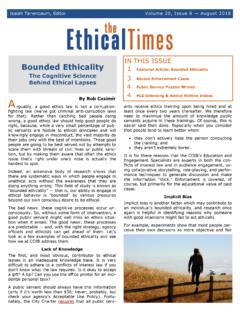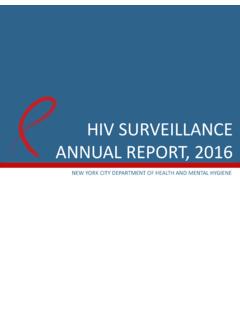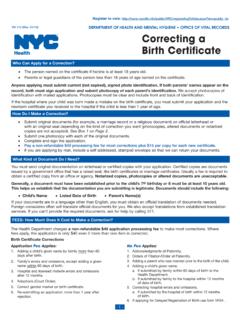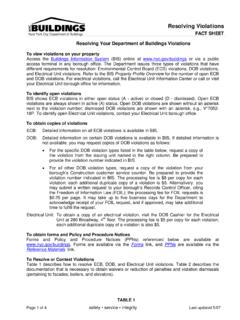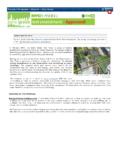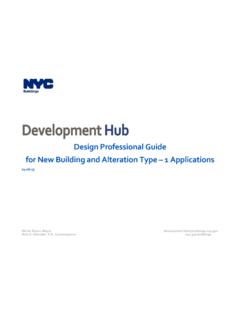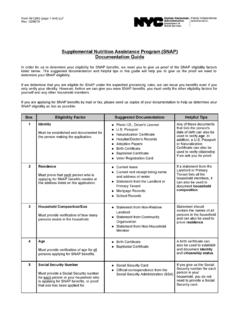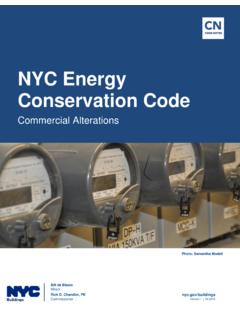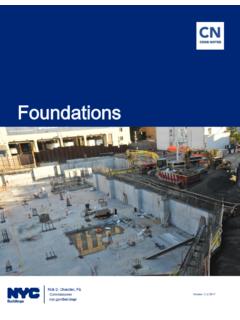Transcription of 2018 Electrical Code Revision Cycle Handbook
1 2018 Electrical Code Revision Cycle Handbook January 2018 1 Table of Contents 1. Background 2 A. Purpose B. New york city Electrical Code C. history of New york city Electrical Code D. Three Year Revision Cycle 2. Goals 3 A. Submit revisions to the city Council B. revisions C. Consensus 3. Code Revision Committee Structure 4 A. Managing Committee B. Technical Committees C. Ad-hoc Working Meetings 4. Code Revision Cycle Process 10 A. Department Review B. Presentation of Proposed revisions C. Committee Review of Proposed revisions D. Legal Review E. Managing Committee Review F. Mediation G. Ad-hoc Working Meetings H. Code of Conduct 2 1. BACKGROUND A.
2 Purpose. The New york city Department of Buildings is mandated to keep the New york city Electrical Code up to date with the latest version of the National Electrical Code (NEC). To this end, the Department is organizing technical committees to help review the 2014 version of the NEC and draft amendments that adapt the national standards to the unique requirements of building and construction in the city of New york B. New york city Electrical Code. The current 2011 New york city Electrical Code (NYCEC) consists of administrative and technical provisions. The technical provisions are based on the 2008 NEC with NYC amendments. The administrative provisions contain construction and maintenance, licensing, fees, and other provisions that apply universally to the Electrical Code.
3 The Electrical Code protects public health, safety, and general welfare by establishing minimum requirements for safe installation of Electrical systems. C. history of New york city Electrical Code. New york city has one of the longest histories of building safety regulation in the United States. The late 19th century and early 20th century witnessed tremendous advancement with electricity as well as other construction related aspects of building residential and commercial property in New york city , pushing buildings to heights never before dreamed possible. Building laws accommodated the new technology. Plumbers were licensed in 1881. Rules for elevators were promulgated in 1885. In 1889, regulations governing outdoor wiring were issued.
4 In 1913, New york city published the first set of rules and regulations for all Electrical installations, and by 1915 these evolved into the city 's first Electrical Code. Adopted in 1915, the New york city Electrical Code reflected the first set of codified Electrical standards in the United States. This modern code provided a foundation that helped spur the growth our city experienced over the next century. As the last century drew to a close, however, the existing Electrical Code had become increasingly unwieldy and outdated. Despite substantial changes and improvements in Electrical technology, the code had not undergone a major Revision since its 1987 edition.
5 Local Law 64 of 2001 addressed these shortcomings of the Electrical Code by replacing it with the 1999 National Fire Protection Association s National Electrical Code ( NEC ), NFPA 70. The legislation required periodic Revision of the Code s technical provisions, ensuring that the Code will always be up-to-date and reflect the latest standards. It was followed by Local Law 41 of 2002, a prerequisite to completing the new Code, as it adopted amendments tailoring the 3 NEC to the specific needs of the city s high-density urban environment. The first Revision in this new scheme was Local Law 81 of 2003, which adopted NEC 2002 with amendments. Local Law 49 of 2006, adopting NEC 2005 with amendments, followed three years later.
6 Finally the current code, enacted by Local Law 39 of 2011, adopted the 2008 edition of the NEC with amendments, and became effective July 1, 2011. After 2011 the New york city Council enacted many local laws to improve the code including those resulting from our collective experiences in 2013 from Super Storm Sandy. These local laws improved the resiliency of the city with the introduction of mitigation against flood hazards, and improved backup power readiness of buildings. D. Periodic revisions . To ensure the city s Electrical provisions remain current, Local Law 64 of 2001 required a mandatory periodic Revision of the Code's technical provisions, thereby ensuring that the Code would always be up-to-date.
7 As a result, beginning in 2003, and continuing every third year thereafter, the Department of Buildings has been required to submit proposed amendments of the Code based upon the latest edition of the NEC to the city Council. 2. GOALS A. Submit revisions to the city Council. All revisions to the New york city Electrical Code must be incorporated into a local law, approved by the New york city Council and signed into law by the mayor. B. revisions . This New york city Electrical Code Revision Cycle is intended to incorporate the 2014 NEC with NYC appropriate amendments. Additionally, amendments will address the following: i. Mirror the NYC Construction Codes Revision process.
8 Efforts will be made to harmonize the NYC Electrical Code with the Construction Codes, in both Revision process and requirements. This effort will mirror the process the Department successfully used to revise the construction codes that includes the use of technical committees that reach consensus regarding the NYC-specific amendments. (See below for more details.) ii. Carry over previous amendments as necessary. Amendments resulting from previous code Revision efforts will be assessed in the context of the 2014 NEC provisions, and incorporated into amendments as necessary. iii. New technology. Efforts will be made to accommodate new, safer equipment and energy saving technologies by incorporating the latest national standards.
9 4 iv. Cost savings. Efforts will be made to reduce, streamline, or eliminate costly, out of date, or inefficient code provisions while maintaining public safety. C. Consensus. Achieving consensus on all proposed amendments to the 2014 NEC is vital to ensuring a code that is balanced and will meet the needs of the diverse built environment of New york city . A consensus-based approach is a process in which committee members work together to find a mutually acceptable solution. This definition does not mean unanimity of thought or abandonment of values. Indeed, one of the characteristics of a well-constructed agreement is that it represents diverse values and interests.
10 Agreement is an acknowledgment that things can move forward, that participants support a decision even if it may not be exactly as initially envisioned. Given the variety of issues under consideration, the resulting agreement often garners varying levels of enthusiasm and support, but on balance, is one that each stakeholder can accept. The consensus processes used to develop revisions for the New york city Electrical Code Revision process will be bound by the following principles: i. Consensus Decision Making. All technical committees will make decisions by unanimous agreement rather than by majority vote. ii. Inclusiveness. All necessary interests will be represented on the committees.
